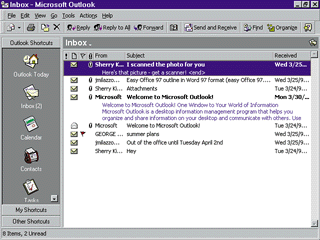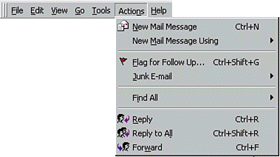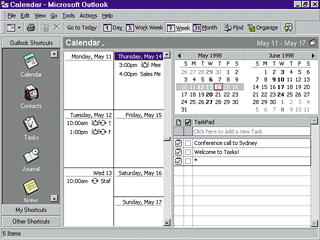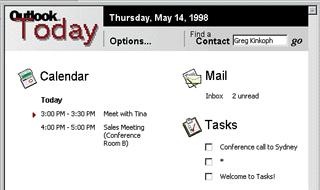|
Introduction
The Outlook window features the familiar title bar, menu bar, toolbar, and status bar
used in other Office 97 programs. In addition, you see the Outlook Bar on the left
side of the window. Use the Outlook Bar to access each Outlook component. Outlook's
components are organized into folders, represented by icons on the Outlook Bar. When
you click a component, such as Inbox, the appropriate folder opens in the work area.
|
Step 1: The Profile Box

When you start Outlook 98, a Choose Profile dialog box appears. For now, click OK to continue. You can always set up a personalized profile later. (To set a personalized profile, click the New button and set up a new profile.)

|
Step 2: View the Outlook Window

The Outlook window contains many of the same program elements used in other
Office 97 programs. Use the Minimize, Maximize, and Close buttons at the far
right end of the title bar to manipulate the Outlook 98 window.

|
Step 3: Use the Menu Bar

To display an Outlook menu, click the menu name. The menu drops down to reveal a
list of commands. Select the command you want to use.

|
Step 4: Use the Toolbar

Outlook's toolbar buttons change to reflect the component or task you're
working on. To activate a toolbar button, just click it. To learn more about
what a button does, hover your mouse pointer over the button to reveal a ScreenTip.

|
Step 5: Use Group Buttons

The Outlook Bar has three group buttons that organize your folders and shortcuts:
Outlook Shortcuts (which hold all the Outlook components), My Shortcuts (which hold
various folders for sent messages, drafts, and more), and Other Shortcuts (lets you
access My Computer, My Documents, and Favorites folders). To display a new folder
group, click the appropriate group button.

|
Step 6: Change Folders

Each Outlook component has its own folder, represented by an icon on the Outlook Bar
in the Outlook Shortcuts group. To open another Outlook component, click the appropriate
icon in the Outlook Bar. To open the Calendar feature, for example, click the Calendar icon.
Use the scroll button to view more icons on the Outlook Bar.

|
Step 7: Display the Folder List

Another way to view Outlook's components is with the Folder List. Open the View menu
and select Folder List, or click the Folder drop-down arrow in the work area. The
Folder List displays each Outlook folder, including any you add to organize Outlook
items you create. (Click the Pushpin icon to keep the Folder List open onscreen.)

|
Step 8: Change Views

Some of the Outlook components let you change your view of the information presented. Calendar, for example, lets you see your schedule by Day, Work Week, Week, and Month. To change a view, use the View menu or click the appropriate view button on the toolbar.

|
Step 9: Use Outlook Today View

A new feature in Outlook 98 is the Outlook Today folder (click the Outlook Today
icon on the Outlook Bar to open). This lets you see your day's schedule and projects
at a glance. The items displayed are actually hyperlinks to other Outlook items.
Click an appointment, for example, to open the Appointment window that has details
about the appointment.

|
Step 10: Find Outlook Contacts

Use the Find a Contact tool at the top of the Outlook Today display to quickly look up
a name in your Contacts database. Click inside the text box and type the person's name.
Press Enter, and Outlook displays the Contact form with details about the person.

|
